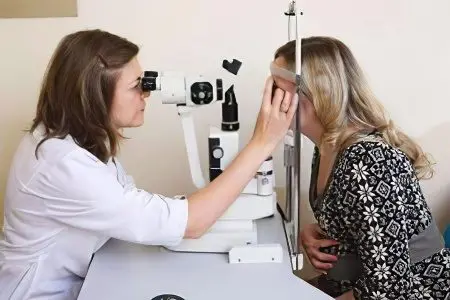
Myopia 3 high degree is a serious disease, characterized by the fact that the image is focused not on the retina, but in front of it, while the distance is 6 diopters or more. Myopia of the 3rd degree is dangerous for its severe complications, primarily from which the fundus and its vessels suffer.
According to statistics, the number of people with high myopia is from 6 to 8% of the total number of cases.
Symptoms of myopia 3 degrees
A person with first-degree myopia has difficulty seeing distant objects. People with a third degree practically do not see them, since the world around them merges without glasses.
Therefore, the symptoms of high myopia are as follows:
Inability to distinguish objects at a distance of more than 10 cm.
Head and eye pain.
Thinning of the retina and blood vessels of the eye.
retinal dystrophy.
High eye fatigue.
Squinting of the eyes.
Eye lengthening.
Often, third-degree myopia is accompanied by astigmatism. In this regard, there are additional symptoms, such as: double vision, blurred images, distortion of objects of vision.
If myopia was not congenital, then most often it manifests itself between the ages of 7 and 12 years and can progress rapidly. Until the age of 20, when eye growth ends, a person can completely lose sight if the disease has not been corrected in time. Moreover, it is a high degree of myopia that is fraught with complications.
Causes of myopia 3 degrees
Among the reasons leading to the development of myopia are the following:
Hereditary predisposition to the development of the disease. Especially often myopia occurs in those children, both of whose parents suffer from myopia.
The unfavorable ecological situation influences the progression of the disease.
Lack of correction for myopia 1 and 2 severity.
Frequent infectious diseases.
Violations of visual hygiene.
Craniocerebral injury.
Growth in length and deformation of the eyeball.
Most often, a person with a 3 degree of myopia is assigned either a 2 or 3 disability group. It all depends on the sharpness of the eye, on how narrowed the field of vision is, on whether a person is able to serve himself on his own or not, and he also needs social protection. The first group of visual disability is rarely given and is almost complete blindness of a person.
Treatment of myopia 3 degrees

The primary task that confronts the doctor and the patient with the third degree of myopia is to stop the progression of the disease. It is necessary to cope with it as soon as possible so that myopia does not cause formidable complications, such as cataracts or glaucoma.
It is important to warn a person that he should not experience high physical exertion, that he has serious restrictions on playing sports. Such people should not lift weights, make sudden movements, jump, quickly change body position, experience vibrations or shocks.
As for pregnant women, the third degree of myopia is an unambiguous indication for a caesarean section. It will not be possible to give birth naturally, as this will lead to complete blindness.
However, do not despair if the third degree of myopia was diagnosed, since in most cases this condition is successfully corrected and treatable:
Glasses. First of all, a person needs to correctly select glasses that have high optical power and minus lenses. From the edges, they will be thicker, and as they move towards the center, they become thinner. In addition to standard glasses made of glass, often with high myopia they are made of plastic. This allows you to make correction devices thinner and lighter, and therefore more comfortable to wear.
Lenses. Contact lenses are an alternative to glasses. However, it is worth considering that for all their convenience, with a high degree of myopia, they help to correct vision much worse.
Orthokeratology. There is another method of treatment, which is called orthokeratology. Its essence lies in the fact that during the night rest a person needs to wear special lenses. While a person is sleeping, they act on the cornea, contributing to its flattening. After waking up, the lenses are removed, and the cornea continues to retain its acquired shape throughout the day, significantly improving the vision of a nearsighted person.
laser correction. Sometimes in patients with a high degree of myopia, it is difficult to correct vision with glasses alone. Therefore, it is necessary to resort to surgical intervention. If the disease does not progress and has not reached 15 diopters, then the laser correction method can come to the rescue. By acting on the cornea with a laser, the microsurgeon changes its shape, after which the image is focused on the retina, and not in front of it.
Replacement of the lens. Sometimes a complete replacement of the lens of the eye is required, which will make it possible to get rid of myopia, not exceeding 20 diopters.
Implantation of intraocular lenses. If myopia has not reached 25 diopters, then the implantation of intraocular lenses will help the person regain vision. It is important to consider that no operation can be performed on a person while the disease is progressing. But even under this condition, there are risks of complications, for example, the occurrence of dry eye syndrome, redness of the eye, infection of the organ of vision. In addition, it is worth remembering the possible undesirable consequences of anesthesia. In some cases, a second operation or additional vision correction with glasses or special lenses with an exclusive design may be required.
Vitamins and nootropics. In addition to the general sparing regimen, it is important to undergo medical treatment of the disease prescribed by the doctor. This is a course of nootropic drugs, and vitamin therapy, and the removal of spasm of accommodation, and tissue therapy. Physiotherapy treatment contributes to the fact that the disease either stops completely or progresses at a slower rate.
Author of the article: Degtyareva Marina Vitalievna, ophthalmologist, ophthalmologist









